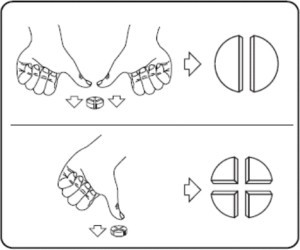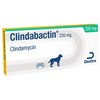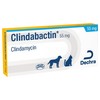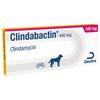Clindabactin
Clindabactin Chewable Tablets are for the treatment of infected wounds and abscesses, and oral cavity infections including periodontal disease in both cats and dogs. They can also be used for the treatment of superficial pyoderma and osteomyelitis in dogs.
Clindabactin Tablets are presented as light brown chewable tablets that are round and convex in shape. They have a cross-shaped break line on one side for easy and accurate dosing.
Clindabactin 220mg Chewable Tablets for Dogs
£2.36Clindabactin 220mg Chewable Tablets are indicated for the treatment of infected wounds and abscesses, and oral cavity infections including periodontal disease in dogs. Clindabactin 220mg...[More info]
Clindabactin 55mg Chewable Tablets for Dogs and Cats
£1.10Clindabactin 55mg Chewable Tablets are indicated for the treatment of infected wounds and abscesses, superficial pyoderma, osteomyelitis, and oral cavity infections including periodontal...[More info]
Clindabactin 440mg Chewable Tablets for Dogs
£2.92Clindabactin 440mg Chewable Tablets are indicated for the treatment of infected wounds and abscesses, and oral cavity infections including periodontal disease in dogs. Product Expiry Date...[More info]
Contraindications
Do not use in cases of hypersensitivity to the active substance or to any of the excipients or to lincomycin. Do not administer to rabbits, hamsters, guinea pigs, chinchillas, horses and ruminants, because ingestion of clindamycin by these species can cause severe gastro-intestinal disturbance which may result in death.
Special warnings for each target species
None
Special precautions for use in animals
The chewable tablets are flavoured. In order to avoid any accidental ingestion, store tablets out of reach of the animals.
Use of the product should be based on susceptibility testing of the bacteria isolated from the animal. If this is not possible, therapy should be based on local epidemiological information about susceptibility of the target bacteria.
Official, national and regional antimicrobial policies should be taken into account when the veterinary medicinal product is used.
Use of the product deviating from the instructions given in the SPC may increase the prevalence of bacteria resistant to clindamycin and may decrease the effectiveness of treatment with lincomycin or macrolide antibacterials due to the potential for cross resistance.
Cross-resistance has been demonstrated among lincosamides (including clindamycin), erythromycin and other macrolides.
In some cases (localised or mild lesions; to prevent recurrence), superficial pyoderma can be treated topically. The need for and duration of systemic antimicrobial treatment should be based on careful consideration of the individual case.
During prolonged therapy of one month or greater, periodic liver and kidney function tests and blood counts should be performed.
Animals with severe renal and/or very severe hepatic disturbances accompanied by severe metabolic aberrations should be dosed with caution and should be monitored by serum examination during high-dose clindamycin therapy.
The use of the product is not recommended in neonates.
Special precautions to be taken by the person administering the veterinary medicinal product to animals
Lincosamides (lincomycin, clindamycin, pirlimycin) may cause hypersensitivity (allergy) reactions. People with known hypersensitivity to lincosamides should avoid contact with the veterinary medicinal product.
Wash hands after handling tablets.
Accidental ingestion may result in gastro-intestinal effects such as abdominal pain and diarrhoea. Care should be taken to avoid accidental ingestion.
In order to reduce the risk of accidental ingestion by children, do not take the tablets out of the blister until ready to administer to the animal. Return part-used tablets into the blister and carton and use at the subsequent administration.
In case of accidental ingestion, particularly by children, seek medical advice immediately and show the package leaflet or the label to the physician.
Adverse reactions (frequency and seriousness)
Vomiting and diarrhoea have been observed uncommonly.
Clindamycin uncommonly causes the overgrowth of non-sensitive organisms such as resistant clostridia and yeasts. In cases of superinfection, appropriate measures must be taken according to the clinical situation.
The frequency of adverse reactions is defined using the following convention:
- very common (more than 1 in 10 animals treated displaying adverse reaction(s))
- common (more than 1 but less than 10 animals in 100 animals treated)
- uncommon (more than 1 but less than 10 animals in 1,000 animals treated)
- rare (more than 1 but less than 10 animals in 10,000 animals treated)
- very rare (less than 1 animal in 10,000 animals treated, including isolated reports)
Use during pregnancy and lactation
While high dose studies in rats suggest that clindamycin is not a teratogen and does not significantly affect the breeding performance of males and females, safety in gestating bitches/queens or breeding male dogs/cats has not been established. Clindamycin crosses the placental and the blood-milk barrier.
Treatment of lactating females can cause diarrhoea in puppies and kittens.
Use only according to the benefit/risk assessment by the responsible veterinarian.
Interaction with other medicinal products and other forms of interaction
Clindamycin hydrochloride has been shown to have neuromuscular blocking properties that may enhance the action of other neuromuscular blocking agents. The product should be used with caution in animals receiving such agents.
Aluminium salts and hydroxides, kaolin and aluminium-magnesium-silicat complex may reduce the absorption of lincosamides. These digestive substances should be administered at least 2 hours before clindamycin.
Clindamycin should not be used concomitantly with or immediately after erythromycin or other macrolides to prevent macrolide-induced resistance to clindamycin.
Clindamycin may reduce plasma levels of cyclosporine with a risk of lack of activity.
During the simultaneous use of clindamycin and aminoglycosides (e.g.gentamicin), the risk of adverse interactions (acute renal failure) cannot be excluded.
Clindamycin should not be used concomitantly with chloramphenicol or macrolides as they antagonise each other at their site of action at the 50S ribosomal sub-unit.
Amounts to be administered and administration route
Oral use.
1. For the treatment of infected wounds and abscesses, and oral cavity infections including periodontal disease in dogs and cats, administer either:
• 5.5 mg/kg of bodyweight every 12 hours for 7-10 days, or
• 11 mg/kg of bodyweight every 24 hours for 7-10 days
If no clinical response is seen within 4 days, redetermine the diagnosis.
2. For the treatment of superficial pyoderma in dogs, administer either:
• 5.5 mg/kg of bodyweight every 12 hours, or
• 11 mg/kg of bodyweight every 24 hours
Therapy of canine superficial pyoderma is usually recommended for 21 days, with shortening or extension of therapy based on clinical judgement.
3. For the treatment of osteomyelitis in dogs, administer:
• 11 mg/kg of bodyweight every 12 hours for a minimum of 28 days
If no clinical response is seen within 14 days, the treatment should be stopped and the diagnosis redetermined.
To ensure a correct dosage, bodyweight should be determined as accurately as possible to avoid under-dosing. Tablets can be divided into 2 or 4 equal parts to ensure accurate dosing. Place the tablet on a flat surface, with its scored side facing up and the convex (rounded) side facing the surface.

2 equal parts: press down with your thumbs on both sides of the tablet.
4 equal parts: press down with your thumb in the middle of the tablet.
Overdose (symptoms, emergency procedures, antidotes)
In dogs, oral doses of clindamycin up to 300 mg/kg/day did not result in toxicity. Dogs receiving 600 mg/kg/day of clindamycin developed anorexia, vomiting and weight loss. Vomiting was also recorded in cats dosed at 25 or 50 mg/kg/day. In cases of overdose, discontinue treatment immediately and establish symptomatic treatment.
Withdrawal period(s)
Not applicable.


